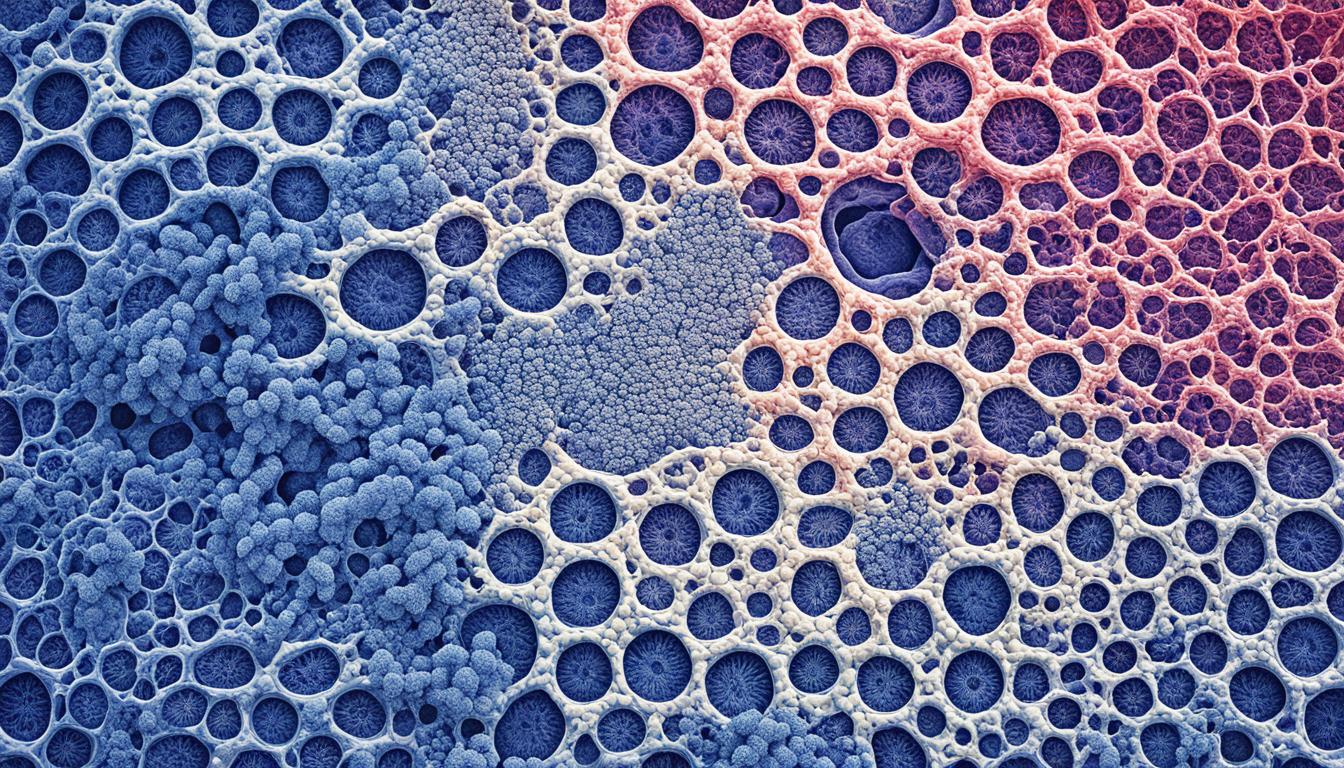Tuberous sclerosis, or TSC, is a rare genetic condition. It causes non-cancerous tumors to grow in several body parts. These include the brain, skin, kidneys, heart, eyes, and lungs.
This condition is present from birth. However, it might not cause problems right away. TSC can lead to health issues like epilepsy and learning disabilities. It can also cause skin problems and breathing difficulties. The effects can vary a lot from one person to another.
Key Takeaways:
- Tuberous sclerosis is a rare genetic condition that causes the development of non-cancerous tumors in various parts of the body.
- The tumors primarily affect the brain, skin, kidneys, heart, eyes, and lungs.
- Tuberous sclerosis can lead to a range of health issues, including epilepsy, learning disabilities, hyperactivity, and skin abnormalities.
- The condition is diagnosed through clinical features, genetic testing, brain imaging, and biopsy of affected tissues.
- While there is no cure for tuberous sclerosis, there are treatment options available to manage the symptoms and associated health problems.
Symptoms and Diagnosis of Tuberous Sclerosis
Tuberous sclerosis is a rare genetic condition. It results in various symptoms that differ from person to person. Common symptoms include epilepsy, learning difficulties, hyperactivity, being on the autism spectrum, and skin problems. These signs might show up when a person is very young or become clear later in life.
It’s key to diagnose tuberous sclerosis accurately for proper care. Doctors usually diagnose it by looking at physical signs, running genetic tests, checking brain images, and sometimes doing a biopsy. Seeking help from a medical expert skilled in tuberous sclerosis diagnosis and treatment is vital.
- Clinical features: Doctors check for physical signs like unusual skin patterns and facial angiofibroma. They also look into conditions like seizures, learning difficulties, and behavior issues.
- Genetic testing: Testing for TSC1 or TSC2 genetic mutations is part of diagnosing. But, not everyone with tuberous sclerosis will show these mutations.
- Brain imaging: Scans like an MRI or CT can show certain brain abnormalities. These findings, such as cortical tubers and subependymal nodules, support the diagnosis.
- Biopsy: In some rare cases, removing a small tissue sample may be needed. This helps confirm the diagnosis by excluding other possibilities.
Spotting tuberous sclerosis early helps in starting the right care and support. It’s crucial to understand how the condition affects daily life. This knowledge is key in creating a care plan tailored to the individual’s needs.
With the right diagnosis and regular health checks, individuals with tuberous sclerosis can get the help they need. This leads to better symptom management and an improved quality of life.
Causes and Treatment of Tuberous Sclerosis
Tuberous sclerosis is caused by changes in the TSC1 or TSC2 genes. These genes control how cells grow. If they change, the growth becomes uncontrolled. This leads to tumors growing in different parts of the body. Most often, these changes happen for no known reason. Sometimes, they are passed on from parents.
At the moment, there’s no cure for tuberous sclerosis. But, there are ways to treat its symptoms and problems. How to treat it depends on each person’s situation.
Medication: To tackle seizures, common in tuberous sclerosis, doctors prescribe antiepileptic drugs. These medicines help lessen the chance of having seizures. They also treat behavioral and mental health issues linked to the disease.
Surgical intervention: If brain tumors cause serious issues, surgery might be needed. This could reduce symptoms and stop future problems. But, not everyone with tuberous sclerosis needs surgery. Doctors consider many factors before suggesting it.
Management of skin abnormalities: Skin issues like facial or ungual fibromas can be lessened with laser treatments or special creams. These methods can make the skin look and feel better.
Management of kidney and lung problems: The disease can also harm the kidneys and lungs. Doctors can suggest treatments to help with these organ problems and breathing issues.
Research into tuberous sclerosis never stops. Scientists look for new treatments and better ways to help. They want to understand the disease more to help those with it.
Groups like the Tuberous Sclerosis Association give support to those affected. They provide resources and a place to learn about the latest treatments. They also help with spreading awareness and fighting for better care.
Conclusion
Tuberous sclerosis is a complex genetic condition affecting physical and neurological health. As of now, there’s no cure for it. Yet, there’s hope through ongoing research. This research aims to enhance diagnosis and treatment, improving life quality for those with the condition.
Support from groups and organizations is key for people and families touched by tuberous sclerosis. They provide essential information, resources, and emotional support. These groups create a community of understanding. They help individuals face challenges and connect with others in similar situations.
Ongoing research is vital for better understanding and handling tuberous sclerosis. By increasing awareness and supporting cooperation between health professionals and researchers, we can overcome this condition. Working together, we can significantly enhance management, prognosis, and treatment for those living with tuberous sclerosis. Let’s make a positive change in their lives.

